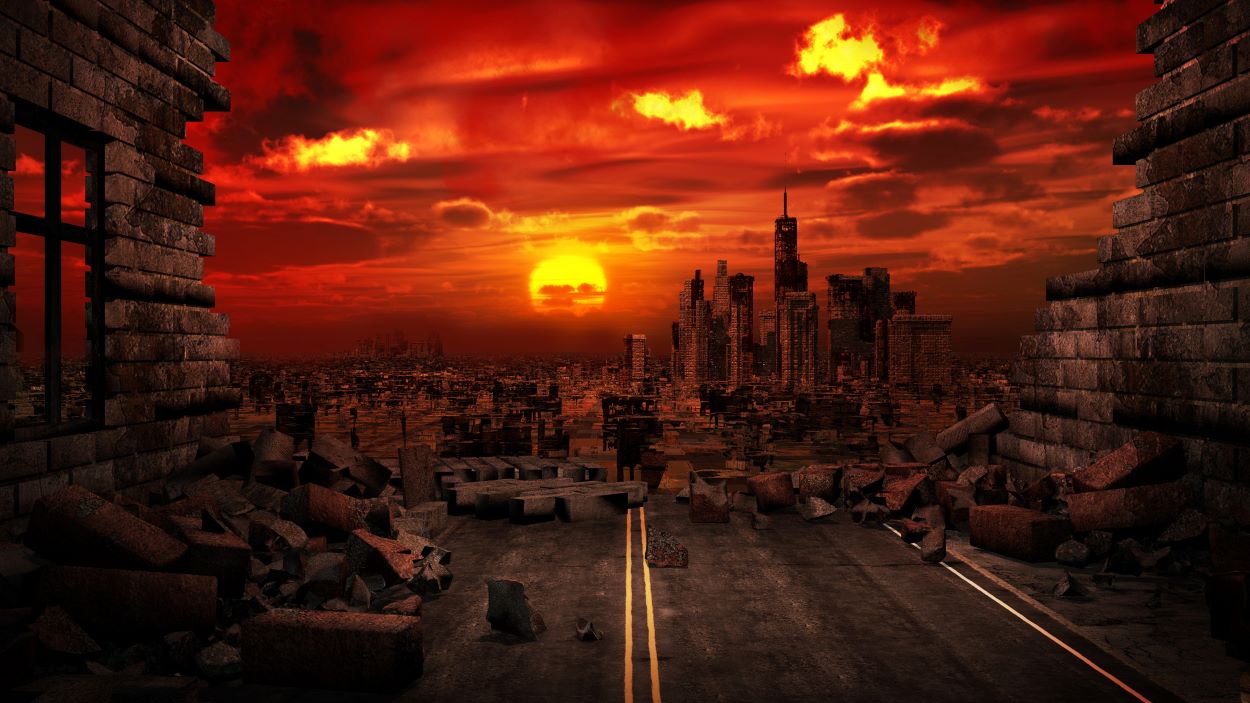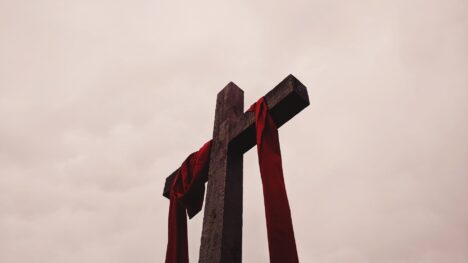
Fire falling from the sky. A massive tsunami. An abandoned city. Let’s be real—it’s probably Los Angeles or New York (although sometimes Sydney or Hong Kong make a cameo).
These are the images we most often associate with the end of the world. Whatever comes to mind for you, no doubt it has been shaped in large part by literature, art and of course, Hollywood. Humans have a morbid curiosity with the apocalyptic, as well as a tendency to explore it in our stories, songs and art.
If I’m being honest, films like The Day After Tomorrow or 2012 hit closer to home now than they did upon first release. Many of us who have gone through lockdowns due to Covid-19 have felt like we’ve been living through our own personal apocalypse. It might come as a surprise to you, then, to discover that one of the important apocalyptic scenes in the book of Revelation in the Bible doesn’t involve any of the above tropes—but a pit, a chain and the devil himself.
Into the abyss
The section of Revelation 20:1–6 scholars call The Millennium or The 1000 Years is bookended by two dramatic moments. In Revelation 19, we see the triumph of Jesus over the “beast and the kings of the earth” (the union of spiritual and human forces into a profane confederacy). In the latter part of Revelation 20, the Devil makes his final stand and is subsequently defeated and cast (his followers with him) into “the lake of fire” (the ultimate resting place of evil). These two scenes have, alongside the Norse Ragnarök, been the inspiration for Armageddon in our modern imagination. In the middle sits the oft-overlooked Millennium.
“And I saw an angel coming down out of heaven, having the key to the Abyss and holding in his hand a great chain. He seized the dragon, that ancient serpent, who is the devil, or Satan, and bound him for a thousand years” (Revelation 20:1, 2).

Right off the bat, we’re confronted with some striking imagery. An angel, holding a key to the Abyss, who locks up the devil for 1000 years. What does it all mean? I’ve found it helpful to frame this scene in the context of one of the most fundamental forces in the universe: freedom. I’ve been asked many times by well-meaning people: “Why does God allow evil?” After all, if He was truly loving, wouldn’t He put an end to suffering once and for all?
Though that sounds nice initially, the question’s dark side is an assumption many of us make about freedom.
True love necessitates freedom, which is of course a double-edged sword. The freedom God gives you and I must also extend to those who choose to abuse it. The power to only do good, with the threat of divine intervention looming over us if we slip up, isn’t truly freedom. It might be a bitter pill for us to swallow, but the fact remains that though freedom risks the possibility of abuse, love must also honour that freedom, regardless of the consequences.
Time’s up for evil
The good news is that this moment in Revelation marks the end of the devil’s free reign on earth. For the entirety of human history, the alluring powers of darkness have posed an existential threat to humanity. From Eden, to the Tower of Babel, to Babylon, their mode of operation has remained the same. They have tempted humans to seize power for themselves, with little regard for those at the bottom, ultimately seeking to redefine good and evil to suit those with power (Genesis 3:4–7). In our pride, humans believed ourselves to be the masters of our own destiny when in reality, the dark powers behind the scenes (Ephesians 6:12) were the ones calling the shots the whole time. For thousands of years, the devil and his forces have had a never-ending supply of humans to torment, but after the triumphal victory of Jesus in Revelation 19, they are suddenly rendered powerless. The image here echoes the promise given to Isaiah thousands of years ago (Isaiah 24:21, 22): though evil is allowed to persist for a time, God will eventually bring it to an end.

But where it’s bad news for the devil, it’s good news for Jesus’ followers.
“I saw thrones on which were seated those who had been given authority to judge. And I saw the souls of those who had been beheaded because of their testimony about Jesus and because of the word of God . . . They came to life and reigned with Christ a thousand years”(Revelation 20:4).
At the very moment that the enemy loses his power, those who have lost their lives (the Greek term is broader than “beheaded,” probably meaning “executed”) for the sake of their faith are elevated to rulers with the Messiah Jesus. This group probably is the same one mentioned in both Revelation 6:9–11 and 14:13. They suffered because of Jesus, in the same way as Jesus, and will in turn be glorified just as Jesus was (Philippians 2:5–11).
But they don’t simply receive exaltation and the responsibility to “judge” because of their self-sacrifice. There is deep restoration happening in this scene, and we’re all invited. It’s bringing us back to where it all started: to the Garden of Eden, and to vocation.
The role you were destined for
When we think of Adam and Eve’s vocation in the garden, many of us assume “gardener” or “caretaker”. However, the biblical authors thought differently. Take for example the opening passages of Genesis where humans are created in the image of God Himself (Genesis 1:26). Or, the Psalmist who declares in wonder how humans were created “just a little lower” than the heavenly divine beings (Psalm 8:5, 6). When we consider these passages, we begin to see God’s original intent for humanity. We were not created, as ancient near-Eastern cultures assumed, to be servants to the gods. Nor are we, as some modern thinkers believe, the result of a cosmic accident.
To view humanity through the lens of the biblical narrative is to see us as divine dirt creatures: formed in the image of God Himself—a God who generously shared His glory with us so that we could be His co-rulers over creation. Our job was not to simply weed gardens or plant trees. We are mirror images of our Creator and our vocation as a species is to reflect His majesty, creativity and love. It’s during the Millennium that God restores the vocation of His lost sons and daughters. Those who hold onto Jesus and who have lived as “new Creation people”, even to the point of death, are restored mind, body and soul alongside Jesus. Scholars have theorised that during these 1000 years, these glorified humans will be given time to explore God’s plan of salvation to see how God has worked with humanity during earth’s history. It’s during this time that God is vindicated—His plan will be confirmed to have been good, just and compassionate the whole time.

The Millennium invites you and I into the story of God’s restoration of humanity and creation. It’s a story where personal choice matters. Freedom is one of the greatest gifts God has given us, but as the saying goes: “Freedom isn’t free.” Our choices matter and will have consequences far into the future.
The good news is this: if you choose to put your trust in Jesus, you can have hope that one day evil will be dealt with once and for all. The future has already been written. Jesus has won, and death will not get the final say.
Jesse Herford is a pastor and associate editor for the Australian/New Zealand edition of Signs of the Times. He lives in Sydney, Australia, with his wife, Carina and their miniature schnauzer, Banjo.








